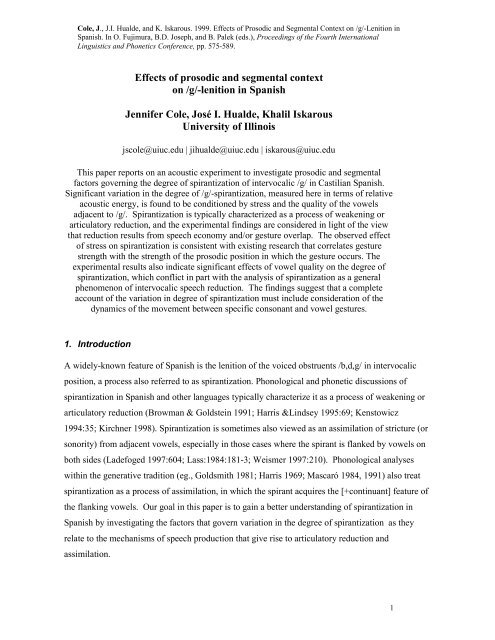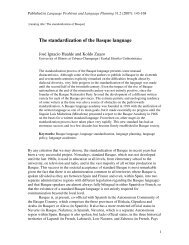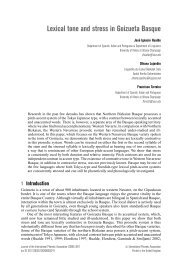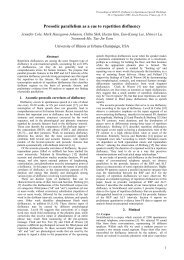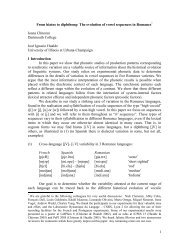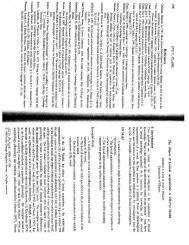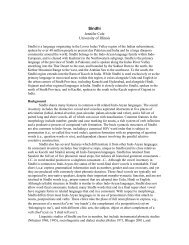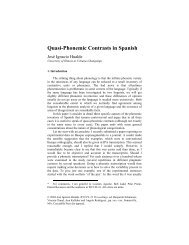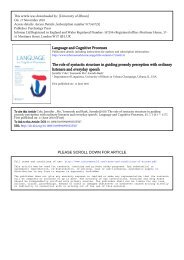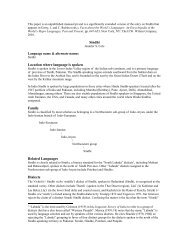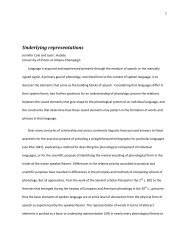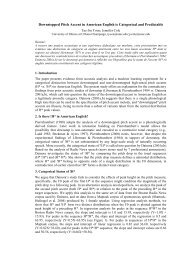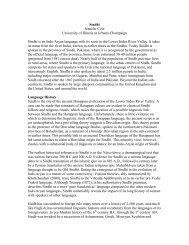Effects of prosodic and segmental context on /g ... - Speech Prosody
Effects of prosodic and segmental context on /g ... - Speech Prosody
Effects of prosodic and segmental context on /g ... - Speech Prosody
You also want an ePaper? Increase the reach of your titles
YUMPU automatically turns print PDFs into web optimized ePapers that Google loves.
Cole, J., J.I. Hualde, <str<strong>on</strong>g>and</str<strong>on</strong>g> K. Iskarous. 1999. <str<strong>on</strong>g>Effects</str<strong>on</strong>g> <str<strong>on</strong>g>of</str<strong>on</strong>g> Prosodic <str<strong>on</strong>g>and</str<strong>on</strong>g> Segmental C<strong>on</strong>text <strong>on</strong> /g/-Leniti<strong>on</strong> in<br />
Spanish. In O. Fujimura, B.D. Joseph, <str<strong>on</strong>g>and</str<strong>on</strong>g> B. Palek (eds.), Proceedings <str<strong>on</strong>g>of</str<strong>on</strong>g> the Fourth Internati<strong>on</strong>al<br />
Linguistics <str<strong>on</strong>g>and</str<strong>on</strong>g> Ph<strong>on</strong>etics C<strong>on</strong>ference, pp. 575-589.<br />
<str<strong>on</strong>g>Effects</str<strong>on</strong>g> <str<strong>on</strong>g>of</str<strong>on</strong>g> <str<strong>on</strong>g>prosodic</str<strong>on</strong>g> <str<strong>on</strong>g>and</str<strong>on</strong>g> <str<strong>on</strong>g>segmental</str<strong>on</strong>g> <str<strong>on</strong>g>c<strong>on</strong>text</str<strong>on</strong>g><br />
<strong>on</strong> /g/-leniti<strong>on</strong> in Spanish<br />
Jennifer Cole, José I. Hualde, Khalil Iskarous<br />
University <str<strong>on</strong>g>of</str<strong>on</strong>g> Illinois<br />
jscole@uiuc.edu | jihualde@uiuc.edu | iskarous@uiuc.edu<br />
This paper reports <strong>on</strong> an acoustic experiment to investigate <str<strong>on</strong>g>prosodic</str<strong>on</strong>g> <str<strong>on</strong>g>and</str<strong>on</strong>g> <str<strong>on</strong>g>segmental</str<strong>on</strong>g><br />
factors governing the degree <str<strong>on</strong>g>of</str<strong>on</strong>g> spirantizati<strong>on</strong> <str<strong>on</strong>g>of</str<strong>on</strong>g> intervocalic /g/ in Castilian Spanish.<br />
Significant variati<strong>on</strong> in the degree <str<strong>on</strong>g>of</str<strong>on</strong>g> /g/-spirantizati<strong>on</strong>, measured here in terms <str<strong>on</strong>g>of</str<strong>on</strong>g> relative<br />
acoustic energy, is found to be c<strong>on</strong>diti<strong>on</strong>ed by stress <str<strong>on</strong>g>and</str<strong>on</strong>g> the quality <str<strong>on</strong>g>of</str<strong>on</strong>g> the vowels<br />
adjacent to /g/. Spirantizati<strong>on</strong> is typically characterized as a process <str<strong>on</strong>g>of</str<strong>on</strong>g> weakening or<br />
articulatory reducti<strong>on</strong>, <str<strong>on</strong>g>and</str<strong>on</strong>g> the experimental findings are c<strong>on</strong>sidered in light <str<strong>on</strong>g>of</str<strong>on</strong>g> the view<br />
that reducti<strong>on</strong> results from speech ec<strong>on</strong>omy <str<strong>on</strong>g>and</str<strong>on</strong>g>/or gesture overlap. The observed effect<br />
<str<strong>on</strong>g>of</str<strong>on</strong>g> stress <strong>on</strong> spirantizati<strong>on</strong> is c<strong>on</strong>sistent with existing research that correlates gesture<br />
strength with the strength <str<strong>on</strong>g>of</str<strong>on</strong>g> the <str<strong>on</strong>g>prosodic</str<strong>on</strong>g> positi<strong>on</strong> in which the gesture occurs. The<br />
experimental results also indicate significant effects <str<strong>on</strong>g>of</str<strong>on</strong>g> vowel quality <strong>on</strong> the degree <str<strong>on</strong>g>of</str<strong>on</strong>g><br />
spirantizati<strong>on</strong>, which c<strong>on</strong>flict in part with the analysis <str<strong>on</strong>g>of</str<strong>on</strong>g> spirantizati<strong>on</strong> as a general<br />
phenomen<strong>on</strong> <str<strong>on</strong>g>of</str<strong>on</strong>g> intervocalic speech reducti<strong>on</strong>. The findings suggest that a complete<br />
account <str<strong>on</strong>g>of</str<strong>on</strong>g> the variati<strong>on</strong> in degree <str<strong>on</strong>g>of</str<strong>on</strong>g> spirantizati<strong>on</strong> must include c<strong>on</strong>siderati<strong>on</strong> <str<strong>on</strong>g>of</str<strong>on</strong>g> the<br />
dynamics <str<strong>on</strong>g>of</str<strong>on</strong>g> the movement between specific c<strong>on</strong>s<strong>on</strong>ant <str<strong>on</strong>g>and</str<strong>on</strong>g> vowel gestures.<br />
1. Introducti<strong>on</strong><br />
A widely-known feature <str<strong>on</strong>g>of</str<strong>on</strong>g> Spanish is the leniti<strong>on</strong> <str<strong>on</strong>g>of</str<strong>on</strong>g> the voiced obstruents /b,d,g/ in intervocalic<br />
positi<strong>on</strong>, a process also referred to as spirantizati<strong>on</strong>. Ph<strong>on</strong>ological <str<strong>on</strong>g>and</str<strong>on</strong>g> ph<strong>on</strong>etic discussi<strong>on</strong>s <str<strong>on</strong>g>of</str<strong>on</strong>g><br />
spirantizati<strong>on</strong> in Spanish <str<strong>on</strong>g>and</str<strong>on</strong>g> other languages typically characterize it as a process <str<strong>on</strong>g>of</str<strong>on</strong>g> weakening or<br />
articulatory reducti<strong>on</strong> (Browman & Goldstein 1991; Harris &Lindsey 1995:69; Kenstowicz<br />
1994:35; Kirchner 1998). Spirantizati<strong>on</strong> is sometimes also viewed as an assimilati<strong>on</strong> <str<strong>on</strong>g>of</str<strong>on</strong>g> stricture (or<br />
s<strong>on</strong>ority) from adjacent vowels, especially in those cases where the spirant is flanked by vowels <strong>on</strong><br />
both sides (Ladefoged 1997:604; Lass:1984:181-3; Weismer 1997:210). Ph<strong>on</strong>ological analyses<br />
within the generative traditi<strong>on</strong> (eg., Goldsmith 1981; Harris 1969; Mascaró 1984, 1991) also treat<br />
spirantizati<strong>on</strong> as a process <str<strong>on</strong>g>of</str<strong>on</strong>g> assimilati<strong>on</strong>, in which the spirant acquires the [+c<strong>on</strong>tinuant] feature <str<strong>on</strong>g>of</str<strong>on</strong>g><br />
the flanking vowels. Our goal in this paper is to gain a better underst<str<strong>on</strong>g>and</str<strong>on</strong>g>ing <str<strong>on</strong>g>of</str<strong>on</strong>g> spirantizati<strong>on</strong> in<br />
Spanish by investigating the factors that govern variati<strong>on</strong> in the degree <str<strong>on</strong>g>of</str<strong>on</strong>g> spirantizati<strong>on</strong> as they<br />
relate to the mechanisms <str<strong>on</strong>g>of</str<strong>on</strong>g> speech producti<strong>on</strong> that give rise to articulatory reducti<strong>on</strong> <str<strong>on</strong>g>and</str<strong>on</strong>g><br />
assimilati<strong>on</strong>.<br />
1
A number <str<strong>on</strong>g>of</str<strong>on</strong>g> works <strong>on</strong> Spanish ph<strong>on</strong>etics <str<strong>on</strong>g>and</str<strong>on</strong>g> ph<strong>on</strong>ology have noted that spirantizati<strong>on</strong> is<br />
subject to a certain amount <str<strong>on</strong>g>of</str<strong>on</strong>g> variability within a given dialect or idiolect (Amastae 1986, 1989,<br />
1995; Zamora & Guitart 1982:102; Barrutia & Terrell 1982:61). C<strong>on</strong>sequently, spirantizati<strong>on</strong> is best<br />
characterized in terms <str<strong>on</strong>g>of</str<strong>on</strong>g> <str<strong>on</strong>g>c<strong>on</strong>text</str<strong>on</strong>g>s that favor the c<strong>on</strong>tinuant or n<strong>on</strong>-c<strong>on</strong>tinuant realizati<strong>on</strong> <str<strong>on</strong>g>of</str<strong>on</strong>g> /b,d,g/,<br />
<str<strong>on</strong>g>and</str<strong>on</strong>g> not as an obligatory, categorical ph<strong>on</strong>ological rule (Mascaro 1991). But there is another type <str<strong>on</strong>g>of</str<strong>on</strong>g><br />
variability in spirantizati<strong>on</strong>, <str<strong>on</strong>g>and</str<strong>on</strong>g> that is variati<strong>on</strong> in the degree <str<strong>on</strong>g>of</str<strong>on</strong>g> spirantizati<strong>on</strong>. The c<strong>on</strong>tinuant<br />
alloph<strong>on</strong>es <str<strong>on</strong>g>of</str<strong>on</strong>g> /b,d,g/ have been described by Quilis (1988: 221-224) as ranging from narrow<br />
fricative segments to approximants with vowel-like qualities, a descripti<strong>on</strong> which is based <strong>on</strong> visual<br />
inspecti<strong>on</strong> <str<strong>on</strong>g>of</str<strong>on</strong>g> spectograms <str<strong>on</strong>g>and</str<strong>on</strong>g> auditory impressi<strong>on</strong>.<br />
The data in (1) present typical examples <str<strong>on</strong>g>of</str<strong>on</strong>g> the <str<strong>on</strong>g>c<strong>on</strong>text</str<strong>on</strong>g>s where spirantizati<strong>on</strong> occurs. The<br />
voiced obstruents /b,d,g/ are realized as c<strong>on</strong>tinuants [B, D, V] respectively, in intervocalic positi<strong>on</strong>,<br />
both word-internally (1a) <str<strong>on</strong>g>and</str<strong>on</strong>g> across word boundaries (1b).<br />
(1) a. sabe [sáBe] ‘s/he knows’<br />
lado [láDo] ‘side’<br />
lago [láVo] ‘lake’<br />
b. la bala [laBála] ‘the bullet’<br />
para dos [pa\aDós] ‘for two’<br />
mala gota [malaVóta] ‘bad drop’<br />
Acoustic analysis reveals that the c<strong>on</strong>tinuant alloph<strong>on</strong>es [B, D, V] have very little highfrequency<br />
n<strong>on</strong>-periodic energy, <str<strong>on</strong>g>and</str<strong>on</strong>g> are thus better defined as approximants than as fricatives or<br />
spirants (Romero 1995). 1 Both in the present study an in our earlier pilot study <strong>on</strong> Spanish<br />
spirantizati<strong>on</strong>, we find that there is c<strong>on</strong>siderable variati<strong>on</strong> in the amount <str<strong>on</strong>g>of</str<strong>on</strong>g> overall energy c<strong>on</strong>tained<br />
in the c<strong>on</strong>s<strong>on</strong>ant regi<strong>on</strong> <str<strong>on</strong>g>of</str<strong>on</strong>g> intervocalic /b,d,g/, with tokens ranging from a complete stop to a vocalic<br />
glide. C<strong>on</strong>sider the spectogram in figure 1 <str<strong>on</strong>g>of</str<strong>on</strong>g> the phrase pide todo ‘ask for everything’. This phrase<br />
c<strong>on</strong>tains two instances <str<strong>on</strong>g>of</str<strong>on</strong>g> /d/ in intervocalic positi<strong>on</strong>, each following a word-level stressed vowel.<br />
The /d/ in pide has the small amount <str<strong>on</strong>g>of</str<strong>on</strong>g> acoustic energy characteristic <str<strong>on</strong>g>of</str<strong>on</strong>g> a voiced stop, while the /d/<br />
1 Although Quilis describes c<strong>on</strong>tinuant alloph<strong>on</strong>es that are narrow fricatives, we find very few tokens that<br />
fit that descripti<strong>on</strong> in our data.<br />
2
in todo has much more energy, <str<strong>on</strong>g>and</str<strong>on</strong>g> is in fact difficult to distinguish visually from the regi<strong>on</strong>s <str<strong>on</strong>g>of</str<strong>on</strong>g> the<br />
flanking vowels. 2<br />
Figure 1: Variati<strong>on</strong> in the realizati<strong>on</strong> <str<strong>on</strong>g>of</str<strong>on</strong>g> intervocalic /d/ in a single utterance.<br />
The qualitative aspect <str<strong>on</strong>g>of</str<strong>on</strong>g> variati<strong>on</strong> in spirantizati<strong>on</strong> goes unreported in nearly all published<br />
work <strong>on</strong> Spanish ph<strong>on</strong>ology <str<strong>on</strong>g>and</str<strong>on</strong>g> ph<strong>on</strong>etics. The majority <str<strong>on</strong>g>of</str<strong>on</strong>g> investigators rely instead <strong>on</strong> a simple<br />
binary distincti<strong>on</strong> between c<strong>on</strong>tinuant <str<strong>on</strong>g>and</str<strong>on</strong>g> n<strong>on</strong>-c<strong>on</strong>tinuant alloph<strong>on</strong>es. 3<br />
2. Sources <str<strong>on</strong>g>of</str<strong>on</strong>g> variati<strong>on</strong><br />
Under the view that spirantizati<strong>on</strong> results from the mechanisms <str<strong>on</strong>g>of</str<strong>on</strong>g> speech producti<strong>on</strong> that govern<br />
reducti<strong>on</strong> <str<strong>on</strong>g>and</str<strong>on</strong>g> assimilati<strong>on</strong>, we are led to c<strong>on</strong>sider two possible sources for variati<strong>on</strong> in the degree <str<strong>on</strong>g>of</str<strong>on</strong>g><br />
2 This example, culled from our earlier pilot study, is shown here because it illustrates variati<strong>on</strong> in the<br />
spirantizati<strong>on</strong> <str<strong>on</strong>g>of</str<strong>on</strong>g> /d/ in the speech <str<strong>on</strong>g>of</str<strong>on</strong>g> a single speaker, within a single utterance. Similar variati<strong>on</strong> can be<br />
seen for each speaker in the experiment reported here, by comparing /g/ tokens across stimuli; there is no<br />
single stimulus item that c<strong>on</strong>tains more than <strong>on</strong>e token <str<strong>on</strong>g>of</str<strong>on</strong>g> /g/. In Figure 1, the segmentati<strong>on</strong> indicated by the<br />
spectrogram labeling is aided by auditory impressi<strong>on</strong>, <str<strong>on</strong>g>and</str<strong>on</strong>g> in this case c<strong>on</strong>stitutes <strong>on</strong>ly a rough placement <str<strong>on</strong>g>of</str<strong>on</strong>g><br />
the transiti<strong>on</strong>s between /d/ <str<strong>on</strong>g>and</str<strong>on</strong>g> the adjacent vowels.<br />
3 An excepti<strong>on</strong> is Romero (1995), who argues for a finer distincti<strong>on</strong> than the traditi<strong>on</strong>al binary <strong>on</strong>e, since he<br />
distinguishes approximant <str<strong>on</strong>g>and</str<strong>on</strong>g> fricative alloph<strong>on</strong>es. The latter are identified in realizati<strong>on</strong>s <str<strong>on</strong>g>of</str<strong>on</strong>g> sequences <str<strong>on</strong>g>of</str<strong>on</strong>g><br />
the type /sb/ in certain Andalusian dialects.<br />
3
spirantizati<strong>on</strong>: <str<strong>on</strong>g>prosodic</str<strong>on</strong>g> <str<strong>on</strong>g>and</str<strong>on</strong>g> <str<strong>on</strong>g>segmental</str<strong>on</strong>g> <str<strong>on</strong>g>c<strong>on</strong>text</str<strong>on</strong>g>. Prosodic structure has been found in recent work to<br />
play a role in c<strong>on</strong>diti<strong>on</strong>ing the magnitude <str<strong>on</strong>g>of</str<strong>on</strong>g> an articulatory gesture. <strong>Speech</strong> gestures have been<br />
shown to be affected by their positi<strong>on</strong> in the word <str<strong>on</strong>g>and</str<strong>on</strong>g> phrase, relative to accent <str<strong>on</strong>g>and</str<strong>on</strong>g> initial <str<strong>on</strong>g>and</str<strong>on</strong>g> final<br />
edges. For example, Byrd (1996) <str<strong>on</strong>g>and</str<strong>on</strong>g> Browman & Goldstein (1992), am<strong>on</strong>g others, have shown<br />
that speech gestures in word-initial positi<strong>on</strong> differ in magnitude from gestures in medial <str<strong>on</strong>g>and</str<strong>on</strong>g> final<br />
positi<strong>on</strong>s. Similar findings obtain for gestures in phrase <str<strong>on</strong>g>and</str<strong>on</strong>g> sentence initial positi<strong>on</strong> (Fouger<strong>on</strong> &<br />
Keating 1996, 1997). With respect to accent, Beckman & Edwards (1994), <str<strong>on</strong>g>and</str<strong>on</strong>g> Beckman, Edwards<br />
& Fletcher (1992) show that jaw <str<strong>on</strong>g>and</str<strong>on</strong>g> lip movements are <str<strong>on</strong>g>of</str<strong>on</strong>g>ten larger <str<strong>on</strong>g>and</str<strong>on</strong>g> faster in syllables that bear<br />
word stress or nuclear accent than in unaccented or reduced syllables. Pierrehumbert & Talkin<br />
(1992) dem<strong>on</strong>strate similar results for laryngeal gestures, which are found to be <str<strong>on</strong>g>of</str<strong>on</strong>g> greater<br />
magnitude in positi<strong>on</strong>s <str<strong>on</strong>g>of</str<strong>on</strong>g> <str<strong>on</strong>g>prosodic</str<strong>on</strong>g> strength at the word <str<strong>on</strong>g>and</str<strong>on</strong>g> phrase levels. In another case, deJ<strong>on</strong>g<br />
(1996) argues that flapping in English results from reducti<strong>on</strong> <str<strong>on</strong>g>of</str<strong>on</strong>g> the c<strong>on</strong>s<strong>on</strong>ant closing gesture in<br />
unstressed positi<strong>on</strong>s following the nuclear accent. These findings collectively indicate that<br />
articulatory gestures are greatest in domain-initial positi<strong>on</strong>s relative to n<strong>on</strong>-initial positi<strong>on</strong>, <str<strong>on</strong>g>and</str<strong>on</strong>g> in<br />
positi<strong>on</strong>s <str<strong>on</strong>g>of</str<strong>on</strong>g> word-level stress <str<strong>on</strong>g>and</str<strong>on</strong>g> phrasal accent relative to the corresp<strong>on</strong>ding unstressed or<br />
unaccented positi<strong>on</strong>s. If spirantizati<strong>on</strong> is correctly viewed as a reducti<strong>on</strong> in the magnitude <str<strong>on</strong>g>of</str<strong>on</strong>g> a<br />
c<strong>on</strong>s<strong>on</strong>ant c<strong>on</strong>stricti<strong>on</strong>, i.e., a type <str<strong>on</strong>g>of</str<strong>on</strong>g> articulatory reducti<strong>on</strong>, we then expect to find the greatest<br />
degree <str<strong>on</strong>g>of</str<strong>on</strong>g> spirantizati<strong>on</strong> in intervocalic positi<strong>on</strong>s that are <str<strong>on</strong>g>prosodic</str<strong>on</strong>g>ally weak at the word or phrase<br />
level, <str<strong>on</strong>g>and</str<strong>on</strong>g> less spirantizati<strong>on</strong>, ie., more stop-like realizati<strong>on</strong>s <str<strong>on</strong>g>of</str<strong>on</strong>g> /b,d,g/, in intervocalic positi<strong>on</strong>s that<br />
are <str<strong>on</strong>g>prosodic</str<strong>on</strong>g>ally str<strong>on</strong>g.<br />
Segmental <str<strong>on</strong>g>c<strong>on</strong>text</str<strong>on</strong>g> may also influence the degree <str<strong>on</strong>g>of</str<strong>on</strong>g> spirantizati<strong>on</strong>, under two hypotheses<br />
about speech producti<strong>on</strong>. First, the hypothesis <str<strong>on</strong>g>of</str<strong>on</strong>g> articulatory ec<strong>on</strong>omy (Kohler 1990, 1991;<br />
Lindblom 1983, 1990) indicates that a c<strong>on</strong>s<strong>on</strong>ant closing gesture will involve the minimal<br />
displacement possible from the articulatory c<strong>on</strong>figurati<strong>on</strong> <str<strong>on</strong>g>of</str<strong>on</strong>g> adjacent vowels, so l<strong>on</strong>g as the gesture<br />
still results in a perceptually salient c<strong>on</strong>s<strong>on</strong>ant. Sec<strong>on</strong>d, the hypothesis <str<strong>on</strong>g>of</str<strong>on</strong>g> gestural overlap<br />
(Browman & Goldstein 1989, 1990; Fowler & Saltzman, 1993) states that gestures for adjacent<br />
segments may overlap, especially in cases where the segments make c<strong>on</strong>flicting dem<str<strong>on</strong>g>and</str<strong>on</strong>g>s <strong>on</strong> shared<br />
articulators. 4 Overlap gives rise to gesture blending, which can result in a perceived assimilati<strong>on</strong> in<br />
some cases, or gesture reducti<strong>on</strong> in others. One hypothesis regarding spirantizati<strong>on</strong> is that it results<br />
4 This discussi<strong>on</strong> summarizes Farnetani’s (1997) overview <str<strong>on</strong>g>of</str<strong>on</strong>g> this <str<strong>on</strong>g>and</str<strong>on</strong>g> other models <str<strong>on</strong>g>of</str<strong>on</strong>g> coarticulati<strong>on</strong>.<br />
4
from the opening or “s<strong>on</strong>orizati<strong>on</strong>” <str<strong>on</strong>g>of</str<strong>on</strong>g> the c<strong>on</strong>s<strong>on</strong>ant closing gesture due to overlap with the more<br />
open gesture <str<strong>on</strong>g>of</str<strong>on</strong>g> the vowel. 5<br />
The present study <str<strong>on</strong>g>of</str<strong>on</strong>g> Spanish spirantizati<strong>on</strong> explores variati<strong>on</strong> in the degree <str<strong>on</strong>g>of</str<strong>on</strong>g> spirantizati<strong>on</strong><br />
through an acoustic analysis in which spirantizati<strong>on</strong> is quantified in terms <str<strong>on</strong>g>of</str<strong>on</strong>g> relative acoustic energy<br />
in the c<strong>on</strong>s<strong>on</strong>ant regi<strong>on</strong>. In this study we focus exclusively <strong>on</strong> intervocalic /g/, giving detailed<br />
c<strong>on</strong>siderati<strong>on</strong> to the kinds <str<strong>on</strong>g>of</str<strong>on</strong>g> <str<strong>on</strong>g>segmental</str<strong>on</strong>g> <str<strong>on</strong>g>and</str<strong>on</strong>g> <str<strong>on</strong>g>prosodic</str<strong>on</strong>g> factors that can influence this particular<br />
c<strong>on</strong>s<strong>on</strong>ant closing gesture. We relate our findings to an earlier study <str<strong>on</strong>g>of</str<strong>on</strong>g> ours <strong>on</strong> Spanish<br />
spirantizati<strong>on</strong> that included /b/ <str<strong>on</strong>g>and</str<strong>on</strong>g> /d/ in additi<strong>on</strong> to /g/, which did not however examine <str<strong>on</strong>g>segmental</str<strong>on</strong>g><br />
<str<strong>on</strong>g>c<strong>on</strong>text</str<strong>on</strong>g> in detail. Given the limited scope <str<strong>on</strong>g>of</str<strong>on</strong>g> the present study, our findings speak <strong>on</strong>ly to the<br />
mechanisms involved in velar spirantizati<strong>on</strong>; however, in future research we plan to extend the<br />
study to examine c<strong>on</strong>diti<strong>on</strong>ing factors for the dental <str<strong>on</strong>g>and</str<strong>on</strong>g> bilabial c<strong>on</strong>s<strong>on</strong>ants as well. The<br />
experiment described below looks for c<strong>on</strong>diti<strong>on</strong>ing effects <str<strong>on</strong>g>of</str<strong>on</strong>g> three factors <strong>on</strong> the amount <str<strong>on</strong>g>of</str<strong>on</strong>g> energy<br />
in intervocalic /g/:<br />
• The positi<strong>on</strong> <str<strong>on</strong>g>of</str<strong>on</strong>g> stress relative to /g/: ˈVgV vs. VˈgV<br />
• The quality <str<strong>on</strong>g>of</str<strong>on</strong>g> the preceding vowel: igV, egV vs. ugV, ogV vs. agV<br />
• The quality <str<strong>on</strong>g>of</str<strong>on</strong>g> the following vowel: Vgi, Vge vs. Vgu, Vgo vs. Vga<br />
3. Experimental Methods<br />
3.1 Materials<br />
The acoustic analysis <str<strong>on</strong>g>of</str<strong>on</strong>g> intervocalic /b,d,g/ is based <strong>on</strong> speech data collected from three subjects, 1<br />
female <str<strong>on</strong>g>and</str<strong>on</strong>g> 2 males, all native speakers <str<strong>on</strong>g>of</str<strong>on</strong>g> Castilian Spanish. Each subject read a list <str<strong>on</strong>g>of</str<strong>on</strong>g> 59 words<br />
c<strong>on</strong>taining intervocalic /g/, produced in a carrier phrase, in a normal c<strong>on</strong>versati<strong>on</strong>al style <str<strong>on</strong>g>and</str<strong>on</strong>g> speech<br />
rate. Instructi<strong>on</strong>s were given in Spanish by <strong>on</strong>e <str<strong>on</strong>g>of</str<strong>on</strong>g> the experimenters, who also dem<strong>on</strong>strated the<br />
desired c<strong>on</strong>versati<strong>on</strong>al speaking style. The word list was balanced for the locati<strong>on</strong> <str<strong>on</strong>g>of</str<strong>on</strong>g> stress: half <str<strong>on</strong>g>of</str<strong>on</strong>g><br />
the words had stress <strong>on</strong> the vowel immediately preceding /g/ (ˈVgV), while the other half had stress<br />
<strong>on</strong> the vowel immediately following /g/ (VˈgV). The words also varied in the quality <str<strong>on</strong>g>of</str<strong>on</strong>g> the vowels<br />
preceding <str<strong>on</strong>g>and</str<strong>on</strong>g> following /g/. Each <str<strong>on</strong>g>of</str<strong>on</strong>g> the vowels five /i,e,o,u,a/ occurs in positi<strong>on</strong>s both preceding<br />
<str<strong>on</strong>g>and</str<strong>on</strong>g> following /g/. The fr<strong>on</strong>t vowels /i,e/ were classed together in c<strong>on</strong>structing the stimuli set, as<br />
5 deJ<strong>on</strong>g (1995) discusses this hypothesis as an account <str<strong>on</strong>g>of</str<strong>on</strong>g> English flapping, but rejects it based <strong>on</strong><br />
c<strong>on</strong>flicting evidence from articulatory data.<br />
5
were the n<strong>on</strong>-low back vowels /u,o/. There were roughly equal numbers <str<strong>on</strong>g>of</str<strong>on</strong>g> words with the vowel<br />
preceding /g/ from each <str<strong>on</strong>g>of</str<strong>on</strong>g> the three vowel classes: /i,e/ (21), /u,o/ (21) <str<strong>on</strong>g>and</str<strong>on</strong>g> /a/ (17). Similarly, there<br />
were roughly equal numbers <str<strong>on</strong>g>of</str<strong>on</strong>g> words with the vowel following /g/ from the same classes: /i,e/ (18),<br />
/u,o/ (20), /a/ (21). Each word was repeated three times, for a total <str<strong>on</strong>g>of</str<strong>on</strong>g> 177 tokens per speaker.<br />
3.2 Procedures<br />
Speakers were recorded directly <strong>on</strong>to a Sun Sparc10, using the Entropic ESPS/Waves+ recording<br />
facility. Recording sessi<strong>on</strong>s were c<strong>on</strong>ducted under quiet c<strong>on</strong>diti<strong>on</strong>s. <strong>Speech</strong> was sampled at 8kHz<br />
<str<strong>on</strong>g>and</str<strong>on</strong>g> segmentati<strong>on</strong> <str<strong>on</strong>g>of</str<strong>on</strong>g> the target c<strong>on</strong>s<strong>on</strong>ants <str<strong>on</strong>g>and</str<strong>on</strong>g> flanking vowels was d<strong>on</strong>e using ESPS/Waves+,<br />
based <strong>on</strong> waveform, spectrogram <str<strong>on</strong>g>and</str<strong>on</strong>g> listening.<br />
The digitized speech segments were analyzed to produce an energy measurement for each<br />
target c<strong>on</strong>s<strong>on</strong>ant. The energy measurement is a ratio <str<strong>on</strong>g>of</str<strong>on</strong>g> the time-averaged energy <str<strong>on</strong>g>of</str<strong>on</strong>g> the c<strong>on</strong>s<strong>on</strong>ant<br />
(an RMS measure) to the time-averaged energy <str<strong>on</strong>g>of</str<strong>on</strong>g> the whole word. The ratio measure was d<strong>on</strong>e to<br />
normalize for differences in overall volume <str<strong>on</strong>g>of</str<strong>on</strong>g> individual utterances. 6<br />
4. Results<br />
The energy measurements obtained from the entire data set reveal significant variati<strong>on</strong> for each <str<strong>on</strong>g>of</str<strong>on</strong>g><br />
the three speakers, illustrated in Figure 2 with a chart <str<strong>on</strong>g>of</str<strong>on</strong>g> the range <str<strong>on</strong>g>of</str<strong>on</strong>g> energy values, collapsed over<br />
all c<strong>on</strong>diti<strong>on</strong>s, for each speaker. The findings from this experiment are c<strong>on</strong>sistent with our earlier<br />
pilot study <strong>on</strong> Spanish spirantizati<strong>on</strong>, where we also found significant variati<strong>on</strong> in the degree <str<strong>on</strong>g>of</str<strong>on</strong>g><br />
spirantizati<strong>on</strong> for all three voiced obstruents, /b,d,g/, in the speech <str<strong>on</strong>g>of</str<strong>on</strong>g> 5 speakers <str<strong>on</strong>g>of</str<strong>on</strong>g> Castilian<br />
Spanish.<br />
Three results are obtained from our analysis relevant to the factors that c<strong>on</strong>diti<strong>on</strong> variati<strong>on</strong> in<br />
the degree <str<strong>on</strong>g>of</str<strong>on</strong>g> spirantizati<strong>on</strong>. First, comparing /g/ in words with stress <strong>on</strong> the preceding vowel against<br />
words with stress <strong>on</strong> the following vowel shows that for each speaker, the tokens <str<strong>on</strong>g>of</str<strong>on</strong>g> /g/ in post-stress<br />
positi<strong>on</strong> have significantly more energy than /g/ in pre-stress positi<strong>on</strong> (Student’s t-test, two-tailed, p<br />
< .05), as seen in Figure 3. This finding shows that the producti<strong>on</strong> <str<strong>on</strong>g>of</str<strong>on</strong>g> intervocalic /g/ is influenced<br />
by <str<strong>on</strong>g>prosodic</str<strong>on</strong>g> <str<strong>on</strong>g>c<strong>on</strong>text</str<strong>on</strong>g>. Specifically, /g/ preceding a stressed vowel is str<strong>on</strong>ger, in the sense <str<strong>on</strong>g>of</str<strong>on</strong>g> having a<br />
6 Other normalizati<strong>on</strong> strategies were also evaluated, in which the c<strong>on</strong>s<strong>on</strong>ant energy was normalized against<br />
the energy in the preceding vowel, the following vowel or the stressed vowel. The results were relatively<br />
stable across these various measures.<br />
6
more complete closure, than /g/ preceding an unstressed vowel. In other words, the presence <str<strong>on</strong>g>of</str<strong>on</strong>g> a<br />
following word-level stress inhibits spirantizati<strong>on</strong> <str<strong>on</strong>g>of</str<strong>on</strong>g> /g/. 7<br />
1<br />
/g/ Energy Variati<strong>on</strong><br />
0.9<br />
0.8<br />
0.7<br />
Relative Energy<br />
0.6<br />
0.5<br />
0.4<br />
0.3<br />
0.2<br />
0.1<br />
JH RM MP<br />
Figure 2: Range <str<strong>on</strong>g>of</str<strong>on</strong>g> variati<strong>on</strong> in relative /g/ energy values by subject. Energy values calculated as a<br />
ratio <str<strong>on</strong>g>of</str<strong>on</strong>g> RMS energy in the /g/ interval over the time-averaged energy <str<strong>on</strong>g>of</str<strong>on</strong>g> the whole word. In this <str<strong>on</strong>g>and</str<strong>on</strong>g><br />
subsequent boxplots, the box encloses 50% <str<strong>on</strong>g>of</str<strong>on</strong>g> the data around the median (from the lower quartile<br />
to the upper quartile), while the top <str<strong>on</strong>g>and</str<strong>on</strong>g> bottom brackets extending from the box show the maximum<br />
<str<strong>on</strong>g>and</str<strong>on</strong>g> minimum values, respectively. Outliers are shown as tick marks bey<strong>on</strong>d the value <str<strong>on</strong>g>of</str<strong>on</strong>g> the<br />
maximum or minimum. The median is indicated by the line through the box.<br />
7 The word-level stress in these data was also the nuclear phrase-level stress in most <str<strong>on</strong>g>of</str<strong>on</strong>g> the utterances.<br />
7
1<br />
JH<br />
1<br />
RM<br />
1<br />
MP<br />
0.9<br />
0.9<br />
0.9<br />
0.8<br />
0.8<br />
0.8<br />
0.7<br />
0.7<br />
0.7<br />
Relative Energy<br />
0.6<br />
0.5<br />
0.4<br />
0.6<br />
0.5<br />
0.4<br />
0.6<br />
0.5<br />
0.4<br />
0.3<br />
0.3<br />
0.3<br />
0.2<br />
0.2<br />
0.2<br />
0.1<br />
0.1<br />
0.1<br />
0<br />
0<br />
0<br />
V‘g gV‘<br />
V‘g gV‘<br />
V‘g gV‘<br />
p
amagar<br />
sugus<br />
5000<br />
0<br />
↓g<br />
5000<br />
0<br />
↓g<br />
−5000<br />
0 1000 2000 3000 4000 5000<br />
−5000<br />
0 1000 2000 3000 4000 5000<br />
5000<br />
0<br />
↓g<br />
5000<br />
0<br />
↓g<br />
−5000<br />
0 1000 2000 3000 4000 5000<br />
−5000<br />
0 1000 2000 3000 4000 5000<br />
5000<br />
5000 ↓g<br />
0<br />
↓g<br />
0<br />
−5000<br />
0 1000 2000 3000 4000 5000<br />
−5000<br />
0 1000 2000 3000 4000 5000<br />
Figure 4: Waveform comparis<strong>on</strong> <str<strong>on</strong>g>of</str<strong>on</strong>g> /g/ in the <str<strong>on</strong>g>c<strong>on</strong>text</str<strong>on</strong>g> <str<strong>on</strong>g>of</str<strong>on</strong>g> /a/ <str<strong>on</strong>g>and</str<strong>on</strong>g> /u/ vowels by speaker RM. The left<br />
three panels show [aVa] from three different tokens <str<strong>on</strong>g>of</str<strong>on</strong>g> the word amagar. The right three panels<br />
show [uVu] from three different tokens <str<strong>on</strong>g>of</str<strong>on</strong>g> the word sugus.<br />
The third speaker, MP, showed no significant difference in the energy <str<strong>on</strong>g>of</str<strong>on</strong>g> /g/ in low vowel<br />
<str<strong>on</strong>g>c<strong>on</strong>text</str<strong>on</strong>g>s compared to other vowel <str<strong>on</strong>g>c<strong>on</strong>text</str<strong>on</strong>g>s. Figure 5 shows the comparis<strong>on</strong> between /g/ in the<br />
<str<strong>on</strong>g>c<strong>on</strong>text</str<strong>on</strong>g> <str<strong>on</strong>g>of</str<strong>on</strong>g> /a/ <str<strong>on</strong>g>and</str<strong>on</strong>g> /u,o/ vowels. Comparis<strong>on</strong>s <str<strong>on</strong>g>of</str<strong>on</strong>g> /a/ <str<strong>on</strong>g>c<strong>on</strong>text</str<strong>on</strong>g>s with /i,e/ <str<strong>on</strong>g>c<strong>on</strong>text</str<strong>on</strong>g>s reveals no c<strong>on</strong>sistent<br />
patterns across speakers. The effect <str<strong>on</strong>g>of</str<strong>on</strong>g> /a/, the maximally open vowel, in minimizing spirantizati<strong>on</strong><br />
is unexpected in light <str<strong>on</strong>g>of</str<strong>on</strong>g> the view <str<strong>on</strong>g>of</str<strong>on</strong>g> spirantizati<strong>on</strong> as a process <str<strong>on</strong>g>of</str<strong>on</strong>g> s<strong>on</strong>orizati<strong>on</strong>.<br />
The third result obtained was that for all three speakers /g/ has significantly greater energy in<br />
the <str<strong>on</strong>g>c<strong>on</strong>text</str<strong>on</strong>g> <str<strong>on</strong>g>of</str<strong>on</strong>g> the n<strong>on</strong>-low back vowels /u,o/ than in the <str<strong>on</strong>g>c<strong>on</strong>text</str<strong>on</strong>g> <str<strong>on</strong>g>of</str<strong>on</strong>g> the fr<strong>on</strong>t vowels /i,e/ (Student’s<br />
t-test, two-tailed, p < .05), as shown in Figure 6. This effect <str<strong>on</strong>g>of</str<strong>on</strong>g> /u,o/ cannot be attributed to their<br />
9
lesser height relative to /i,e/, because the lowest vowel <str<strong>on</strong>g>of</str<strong>on</strong>g> all, /a/, c<strong>on</strong>diti<strong>on</strong>s the least energy in<br />
adjacent /g/.<br />
1<br />
JH<br />
1<br />
RM<br />
1<br />
MP<br />
0.9<br />
0.9<br />
0.9<br />
0.8<br />
0.8<br />
0.8<br />
0.7<br />
0.7<br />
0.7<br />
Relative Energy<br />
0.6<br />
0.5<br />
0.4<br />
0.6<br />
0.5<br />
0.4<br />
0.6<br />
0.5<br />
0.4<br />
0.3<br />
0.3<br />
0.3<br />
0.2<br />
0.2<br />
0.2<br />
0.1<br />
0.1<br />
0.1<br />
0<br />
0<br />
0<br />
/a/ /u,o/<br />
/a/ /u,o/<br />
/a/ /u,o/<br />
p
1<br />
JH<br />
1<br />
RM<br />
1<br />
MP<br />
0.9<br />
0.9<br />
0.9<br />
0.8<br />
0.8<br />
0.8<br />
0.7<br />
0.7<br />
0.7<br />
Relative Energy<br />
0.6<br />
0.5<br />
0.4<br />
0.6<br />
0.5<br />
0.4<br />
0.6<br />
0.5<br />
0.4<br />
0.3<br />
0.3<br />
0.3<br />
0.2<br />
0.2<br />
0.2<br />
0.1<br />
0.1<br />
0.1<br />
0<br />
/i,e/ /u,o/<br />
p
1<br />
JH<br />
1<br />
RM<br />
1<br />
MP<br />
0.9<br />
0.9<br />
0.9<br />
0.8<br />
0.8<br />
0.8<br />
0.7<br />
0.7<br />
0.7<br />
Relative Energy<br />
0.6<br />
0.5<br />
0.4<br />
0.6<br />
0.5<br />
0.4<br />
0.6<br />
0.5<br />
0.4<br />
0.3<br />
0.3<br />
0.3<br />
0.2<br />
0.2<br />
0.2<br />
0.1<br />
0.1<br />
0.1<br />
0<br />
0<br />
0<br />
/i,e/ /u,o/<br />
/i,e/ /u,o/<br />
/i,e/ /u,o/<br />
p
two languages: in Spanish the <strong>on</strong>set c<strong>on</strong>s<strong>on</strong>ant ([V] in our data) undergoes a much greater reducti<strong>on</strong><br />
than the following unstressed vowel, which is not subject to nearly the same degree <str<strong>on</strong>g>of</str<strong>on</strong>g> reducti<strong>on</strong> as<br />
an unstressed vowel in English. The inhibitory effect <str<strong>on</strong>g>of</str<strong>on</strong>g> following stress <strong>on</strong> spirantizati<strong>on</strong> is also<br />
c<strong>on</strong>sistent with the results <str<strong>on</strong>g>of</str<strong>on</strong>g> Beckman & Edwards (1994) <str<strong>on</strong>g>and</str<strong>on</strong>g> Beckman, Edwards & Fletcher<br />
(1992) for jaw <str<strong>on</strong>g>and</str<strong>on</strong>g> lip movements, <str<strong>on</strong>g>and</str<strong>on</strong>g> with the results <str<strong>on</strong>g>of</str<strong>on</strong>g> Pierrehumbert & Talkin (1992) for<br />
laryngeal gestures. In all <str<strong>on</strong>g>of</str<strong>on</strong>g> these cases, gestures are found to have greater magnitude in <str<strong>on</strong>g>prosodic</str<strong>on</strong>g>ally<br />
str<strong>on</strong>g positi<strong>on</strong>s (e.g., the <strong>on</strong>set to an accented/stressed syllable), with reduced gestures occurring in<br />
the corresp<strong>on</strong>ding <str<strong>on</strong>g>prosodic</str<strong>on</strong>g>ally weak positi<strong>on</strong>s (e.g., the <strong>on</strong>set to an unaccented/unstressed syllable).<br />
The c<strong>on</strong>diti<strong>on</strong>ing effect <str<strong>on</strong>g>of</str<strong>on</strong>g> stress is <strong>on</strong>e indicati<strong>on</strong> that spirantizati<strong>on</strong> is sensitive to <str<strong>on</strong>g>prosodic</str<strong>on</strong>g><br />
structure. Further evidence was found in our earlier pilot study, where we observed that<br />
spirantizati<strong>on</strong> is largely inhibited in utterance-initial positi<strong>on</strong>. The stop-like realizati<strong>on</strong>s <str<strong>on</strong>g>of</str<strong>on</strong>g> /b,d,g/<br />
that we observed in utterance-initial positi<strong>on</strong> are c<strong>on</strong>sistent with traditi<strong>on</strong>al ph<strong>on</strong>ological<br />
descripti<strong>on</strong>s <str<strong>on</strong>g>of</str<strong>on</strong>g> Spanish, <str<strong>on</strong>g>and</str<strong>on</strong>g> showed much less variati<strong>on</strong> in c<strong>on</strong>stricti<strong>on</strong> degree compared to<br />
intervocalic tokens. Our observati<strong>on</strong>s are also c<strong>on</strong>sistent with the findings <str<strong>on</strong>g>of</str<strong>on</strong>g> Fouger<strong>on</strong> & Keating<br />
(1996,1997) that the initial positi<strong>on</strong> <str<strong>on</strong>g>of</str<strong>on</strong>g> a sentence or phrase c<strong>on</strong>diti<strong>on</strong>s a greater magnitude <str<strong>on</strong>g>of</str<strong>on</strong>g><br />
articulatory gestures. With respect to word-initial positi<strong>on</strong>, our earlier study did not provide<br />
evidence for the finding reported in Byrd (1996) <str<strong>on</strong>g>and</str<strong>on</strong>g> Browman & Goldstein (1992) that articulatory<br />
gestures are str<strong>on</strong>ger in this positi<strong>on</strong>, also. Rather, we found that spirantizati<strong>on</strong> has the same effect<br />
<strong>on</strong> intervocalic /b,d,g/ regardless <str<strong>on</strong>g>of</str<strong>on</strong>g> whether the VCV sequence is word internal or occurs across a<br />
word boundary, as in V#CV.<br />
Our data reveal two c<strong>on</strong>diti<strong>on</strong>ing effects <str<strong>on</strong>g>of</str<strong>on</strong>g> the quality <str<strong>on</strong>g>of</str<strong>on</strong>g> vowels flanking /g/. Spirantizati<strong>on</strong><br />
<str<strong>on</strong>g>of</str<strong>on</strong>g> /g/ is inhibited when it is flanked <strong>on</strong> both sides by the low vowel /a/, when it is flanked <strong>on</strong> both<br />
sides by a fr<strong>on</strong>t vowel /i,e/, or when it is followed by /i,e/. These inhibitory effects <str<strong>on</strong>g>of</str<strong>on</strong>g> vowel quality<br />
<strong>on</strong> spirantizati<strong>on</strong> were an unexpected finding based <strong>on</strong> a view <str<strong>on</strong>g>of</str<strong>on</strong>g> spirantizati<strong>on</strong> as resulting either<br />
from ec<strong>on</strong>omy-driven articulatory reducti<strong>on</strong>, or from gestural overlap. The ec<strong>on</strong>omy hypothesis<br />
requires that the c<strong>on</strong>s<strong>on</strong>ant closing gesture be executed with the minimal displacement from the<br />
adjacent vowels. Since the c<strong>on</strong>stricti<strong>on</strong> locati<strong>on</strong> <str<strong>on</strong>g>of</str<strong>on</strong>g> /a/ is farthest am<strong>on</strong>g all vowels from the<br />
c<strong>on</strong>stricti<strong>on</strong> locati<strong>on</strong> for /g/, we would expect that the closing gesture for /g/ will be effected less<br />
completely in the <str<strong>on</strong>g>c<strong>on</strong>text</str<strong>on</strong>g> <str<strong>on</strong>g>of</str<strong>on</strong>g> flanking /a/ vowels. Our data reveal the opposite pattern. Similarly,<br />
since the movement between /i/ or /e/ <str<strong>on</strong>g>and</str<strong>on</strong>g> a palatalized /g/ is greater than the movement between<br />
(n<strong>on</strong>-palatalized) /g/ <str<strong>on</strong>g>and</str<strong>on</strong>g> /u/ or /o/, we expect <strong>on</strong> the basis <str<strong>on</strong>g>of</str<strong>on</strong>g> ec<strong>on</strong>omy that /g/ c<strong>on</strong>stricti<strong>on</strong> will be<br />
13
more complete in the <str<strong>on</strong>g>c<strong>on</strong>text</str<strong>on</strong>g> <str<strong>on</strong>g>of</str<strong>on</strong>g> /u,o/. Again, our results c<strong>on</strong>flict with this expectati<strong>on</strong>, showing<br />
more complete c<strong>on</strong>stricti<strong>on</strong> in the <str<strong>on</strong>g>c<strong>on</strong>text</str<strong>on</strong>g> <str<strong>on</strong>g>of</str<strong>on</strong>g> the fr<strong>on</strong>t vowels /i,e/ than the back vowels /u,o/. Our<br />
findings are in c<strong>on</strong>flict with the findings <str<strong>on</strong>g>of</str<strong>on</strong>g> Lindblom, Pauli <str<strong>on</strong>g>and</str<strong>on</strong>g> Sundberg (1975), whose bite-block<br />
experiment shows that apical c<strong>on</strong>s<strong>on</strong>ants in VCV utterances are produced with a t<strong>on</strong>gue body<br />
c<strong>on</strong>figurati<strong>on</strong> requiring the least movement from the adjacent vowels. The vowel quality effects<br />
found in our data are similarly unexpected under the analysis <str<strong>on</strong>g>of</str<strong>on</strong>g> spirantizati<strong>on</strong> in terms <str<strong>on</strong>g>of</str<strong>on</strong>g> gesture<br />
overlap. In particular, the overlapping <str<strong>on</strong>g>of</str<strong>on</strong>g> /g/ with an adjacent /a/ is expected to result in the<br />
maximal reducti<strong>on</strong> <str<strong>on</strong>g>of</str<strong>on</strong>g> the /g/ closing gesture, c<strong>on</strong>trary to our findings. The open jaw positi<strong>on</strong> <str<strong>on</strong>g>of</str<strong>on</strong>g> /a/<br />
is expected to exert the greatest opening effect <strong>on</strong> the /g/ closing gesture, compared to vowels<br />
produced with less open jaw positi<strong>on</strong>s. The gesture overlap analysis is perhaps more c<strong>on</strong>sistent with<br />
the inhibitory effects <str<strong>on</strong>g>of</str<strong>on</strong>g> flanking /i,e/ vowels <strong>on</strong> spirantizati<strong>on</strong>, relative to flanking /u,o/. There is<br />
complete sharing <str<strong>on</strong>g>of</str<strong>on</strong>g> the articulators involved in /g/ <str<strong>on</strong>g>and</str<strong>on</strong>g> /u,o/ producti<strong>on</strong>s, <str<strong>on</strong>g>and</str<strong>on</strong>g> less sharing with /g/<br />
<str<strong>on</strong>g>and</str<strong>on</strong>g> /i,e/. Since gesture overlap increases as gestures are increasingly shared between adjacent<br />
targets, the expectati<strong>on</strong> is for greatest overlap, <str<strong>on</strong>g>and</str<strong>on</strong>g> hence greatest spirantizati<strong>on</strong> <str<strong>on</strong>g>of</str<strong>on</strong>g> /g/ in the <str<strong>on</strong>g>c<strong>on</strong>text</str<strong>on</strong>g><br />
<str<strong>on</strong>g>of</str<strong>on</strong>g> adjacent vowels with a dorso-velar c<strong>on</strong>stricti<strong>on</strong>.<br />
The asymmetry between /u,o/ vowels <strong>on</strong> the <strong>on</strong>e h<str<strong>on</strong>g>and</str<strong>on</strong>g>, which c<strong>on</strong>diti<strong>on</strong> greater degrees <str<strong>on</strong>g>of</str<strong>on</strong>g><br />
spirantizati<strong>on</strong>, <str<strong>on</strong>g>and</str<strong>on</strong>g> /i,e/ <str<strong>on</strong>g>and</str<strong>on</strong>g> /a/ vowels <strong>on</strong> the other h<str<strong>on</strong>g>and</str<strong>on</strong>g>, which c<strong>on</strong>diti<strong>on</strong> lesser degrees <str<strong>on</strong>g>of</str<strong>on</strong>g><br />
spirantizati<strong>on</strong>, has a parallel in the articulatory dynamics <str<strong>on</strong>g>of</str<strong>on</strong>g> VgV sequences. Movement between /g/<br />
<str<strong>on</strong>g>and</str<strong>on</strong>g> /i,e/ or /a/ vowels involves a change in the overall positi<strong>on</strong> <str<strong>on</strong>g>of</str<strong>on</strong>g> the t<strong>on</strong>gue body, while there is<br />
virtually no change in t<strong>on</strong>gue body positi<strong>on</strong> for movements between /g/ <str<strong>on</strong>g>and</str<strong>on</strong>g> /u/ or /o/. We suggest<br />
that the effect <str<strong>on</strong>g>of</str<strong>on</strong>g> adjacent vowel quality <strong>on</strong> c<strong>on</strong>stricti<strong>on</strong> degree for /g/ is a c<strong>on</strong>sequence <str<strong>on</strong>g>of</str<strong>on</strong>g> the<br />
dynamics <str<strong>on</strong>g>of</str<strong>on</strong>g> t<strong>on</strong>gue body movement. Movement <str<strong>on</strong>g>of</str<strong>on</strong>g> the t<strong>on</strong>gue body is necessary to produce a<br />
c<strong>on</strong>s<strong>on</strong>ant closing gesture, whether the movement is in the horiz<strong>on</strong>tal dimensi<strong>on</strong>, the vertical<br />
dimensi<strong>on</strong>, or both. When the t<strong>on</strong>gue body positi<strong>on</strong> is changed in the movement between /g/ <str<strong>on</strong>g>and</str<strong>on</strong>g> an<br />
adjacent vowel, the closing gesture for /g/ is most fully realized. But when no overall change in the<br />
t<strong>on</strong>gue body positi<strong>on</strong> is required, as in the movement between /g/ <str<strong>on</strong>g>and</str<strong>on</strong>g> adjacent /u/ or /o/, then the<br />
closing gesture for /g/ is not effectively realized. In support <str<strong>on</strong>g>of</str<strong>on</strong>g> this view, we note that in a number<br />
<str<strong>on</strong>g>of</str<strong>on</strong>g> tokens from our data, it appears that the /g/ is produced as an unrounded velar glide when flanked<br />
by /u,o/ vowels, <str<strong>on</strong>g>and</str<strong>on</strong>g> is barely or not at all distinguishable from the vowels based <strong>on</strong> auditory<br />
impressi<strong>on</strong>. This account <str<strong>on</strong>g>of</str<strong>on</strong>g> vowel quality as a c<strong>on</strong>diti<strong>on</strong>ing factor for spirantizati<strong>on</strong> suggests that<br />
14
different vowel quality effects will be found for the dental <str<strong>on</strong>g>and</str<strong>on</strong>g> bilabial spirants due to differences in<br />
the dynamics <str<strong>on</strong>g>of</str<strong>on</strong>g> the VCV gestures involved. We plan to pursue this hypothesis in future research.<br />
Acknowledgments<br />
The authors gratefully acknowledge the support <str<strong>on</strong>g>of</str<strong>on</strong>g> the University <str<strong>on</strong>g>of</str<strong>on</strong>g> Illinois<br />
Research Board. Cole’s research is supported in part through NSF grant SBR-9319368.<br />
An earlier versi<strong>on</strong> <str<strong>on</strong>g>of</str<strong>on</strong>g> this paper benefited from the helpful guidance <str<strong>on</strong>g>of</str<strong>on</strong>g> Mary Beckman,<br />
John Coleman, <str<strong>on</strong>g>and</str<strong>on</strong>g> Janet Pierrehumbert, who bear no resp<strong>on</strong>sibility for the use to which<br />
we put their advise in the present work.<br />
References<br />
Amastae, J<strong>on</strong>. (1986). A syllable-based analysis <str<strong>on</strong>g>of</str<strong>on</strong>g> Spanish spirantizati<strong>on</strong>. In Carmen<br />
Silva-Corvalán <str<strong>on</strong>g>and</str<strong>on</strong>g> Osvaldo Jaeggli (eds.), Studies in Romance Linguistics (pp. 2-<br />
23). Dordrecht: Foris.<br />
Amastae, J<strong>on</strong>. (1989). The intersecti<strong>on</strong> <str<strong>on</strong>g>of</str<strong>on</strong>g> s-aspirati<strong>on</strong>/deleti<strong>on</strong> <str<strong>on</strong>g>and</str<strong>on</strong>g> spirantizati<strong>on</strong> in<br />
H<strong>on</strong>duran Spanish. Language Variati<strong>on</strong> <str<strong>on</strong>g>and</str<strong>on</strong>g> Change 1:169-183.<br />
Amastae, J<strong>on</strong>. (1995). Variable spirantizati<strong>on</strong>: c<strong>on</strong>straint weighting in three dialects.<br />
Hispanic Linguistics 6/7: 267-285.<br />
Barrutia, Richard <str<strong>on</strong>g>and</str<strong>on</strong>g> Tracy Terrell. (1982). F<strong>on</strong>ética y f<strong>on</strong>ología españolas. New York:<br />
Wiley.<br />
Beckman, Mary <str<strong>on</strong>g>and</str<strong>on</strong>g> Jan Edwards. (1994). Articulatory evidence for differentiating stress<br />
categories. In Patricia A. Keating (ed.), Ph<strong>on</strong>ological Structure <str<strong>on</strong>g>and</str<strong>on</strong>g> Ph<strong>on</strong>etic<br />
Form: Papers in Laboratory Ph<strong>on</strong>ology III (pp. 7-33). Cambridge: Cambridge<br />
University Press.<br />
Beckman, Mary, Jan Edwards <str<strong>on</strong>g>and</str<strong>on</strong>g> Janet Fletcher. (1992). Prosodic structure <str<strong>on</strong>g>and</str<strong>on</strong>g> tempo in<br />
a s<strong>on</strong>ority model <str<strong>on</strong>g>of</str<strong>on</strong>g> articulatory dynamics. In Gerard J. Docherty <str<strong>on</strong>g>and</str<strong>on</strong>g> J. Robert<br />
Ladd (eds.), Papers in Laboratory Ph<strong>on</strong>ology II: Gesture, Segment, <strong>Prosody</strong> (pp.<br />
68-86). Cambridge: Cambridge University Press.<br />
Browman, Catherine <str<strong>on</strong>g>and</str<strong>on</strong>g> Louis Goldstein. (1991). Gestural structures: distinctiveness,<br />
ph<strong>on</strong>ological processes, <str<strong>on</strong>g>and</str<strong>on</strong>g> historical change. In Ignatius G. Mattingly <str<strong>on</strong>g>and</str<strong>on</strong>g><br />
Michael Studdert-Kennedy (eds.), Modularity <str<strong>on</strong>g>and</str<strong>on</strong>g> the Motor Theory <str<strong>on</strong>g>of</str<strong>on</strong>g> <strong>Speech</strong><br />
Percepti<strong>on</strong>: Proceedings <str<strong>on</strong>g>of</str<strong>on</strong>g> a C<strong>on</strong>ference to H<strong>on</strong>or Alvin M. Liberman (pp. 313-<br />
338). Hillsdale, NJ: Lawrence Erlbaum Assoc.<br />
15
Browman, Catherine <str<strong>on</strong>g>and</str<strong>on</strong>g> Louis Goldstein. (1992). Articulatory ph<strong>on</strong>ology: an overview.<br />
Ph<strong>on</strong>etica 49:155-80.<br />
Byrd, Dani. (1996). Influences <strong>on</strong> articulatory timing in c<strong>on</strong>s<strong>on</strong>ant sequences. J. Ph<strong>on</strong>. 24:<br />
209-244.<br />
Cole, Jennifer, José I. Hualde <str<strong>on</strong>g>and</str<strong>on</strong>g> Khalil Iskarous. (1997). Is Spanish spirantizati<strong>on</strong> a<br />
unitary process? Paper presented at LSRL 27, Irvine, CA, February 1997.<br />
DeJ<strong>on</strong>g, Kenneth. (1996). American English flapping revisited. Paper presented at the 5 th<br />
c<strong>on</strong>ference in Laboratory Ph<strong>on</strong>ology, Evanst<strong>on</strong>, Ill.<br />
Farnetani, Edda. (1997). Coarticulati<strong>on</strong> <str<strong>on</strong>g>and</str<strong>on</strong>g> c<strong>on</strong>nected speech processes. In William J.<br />
Hardcastle <str<strong>on</strong>g>and</str<strong>on</strong>g> John Laver (eds.), The H<str<strong>on</strong>g>and</str<strong>on</strong>g>book <str<strong>on</strong>g>of</str<strong>on</strong>g> Ph<strong>on</strong>etic Sciences (pp. 371-<br />
404). Oxford <str<strong>on</strong>g>and</str<strong>on</strong>g> Cambridge, Mass.: Blackwell.<br />
Fouger<strong>on</strong>, Cecile <str<strong>on</strong>g>and</str<strong>on</strong>g> Patricia Keating. (1996). Variati<strong>on</strong>s in velic <str<strong>on</strong>g>and</str<strong>on</strong>g> lingual articulati<strong>on</strong><br />
depending <strong>on</strong> <str<strong>on</strong>g>prosodic</str<strong>on</strong>g> positi<strong>on</strong>s: Results for two French speakers. UCLA<br />
Working Papers in Ph<strong>on</strong>etics 92: 88-96.<br />
Fouger<strong>on</strong>, Cecile <str<strong>on</strong>g>and</str<strong>on</strong>g> Patricia Keating. (1997). Articulatory strengthening at edges <str<strong>on</strong>g>of</str<strong>on</strong>g><br />
<str<strong>on</strong>g>prosodic</str<strong>on</strong>g> domains. JASA 101: 3728-40.<br />
Fowler, Carol <str<strong>on</strong>g>and</str<strong>on</strong>g> Eliott Saltzman. (1993). Coordinati<strong>on</strong> <str<strong>on</strong>g>and</str<strong>on</strong>g> coarticulati<strong>on</strong> in speech<br />
producti<strong>on</strong>. Language <str<strong>on</strong>g>and</str<strong>on</strong>g> <strong>Speech</strong>, 36: 171-95.<br />
Goldsmith, John. (1981). Sub<str<strong>on</strong>g>segmental</str<strong>on</strong>g>s in Spanish ph<strong>on</strong>ology. In William Cressey <str<strong>on</strong>g>and</str<strong>on</strong>g><br />
D<strong>on</strong>na Jo Napoli (eds.), Linguistic Symposium <strong>on</strong> Romance Languages 9 (pp. 1-<br />
16). Washingt<strong>on</strong>, DC: Georgetown University Press.<br />
Harris, James. (1969). Spanish ph<strong>on</strong>ology. Cambridge, MA: MIT Press.<br />
Harris, John <str<strong>on</strong>g>and</str<strong>on</strong>g> Ge<str<strong>on</strong>g>of</str<strong>on</strong>g>f Lindsey. (1995). The elements <str<strong>on</strong>g>of</str<strong>on</strong>g> ph<strong>on</strong>ological representati<strong>on</strong>. In<br />
Jacques Dur<str<strong>on</strong>g>and</str<strong>on</strong>g> <str<strong>on</strong>g>and</str<strong>on</strong>g> Francis Katamba (eds.), Fr<strong>on</strong>tiers <str<strong>on</strong>g>of</str<strong>on</strong>g> Ph<strong>on</strong>ology: Atoms,<br />
Structures, Derivati<strong>on</strong>s (pp. 34-79). L<strong>on</strong>d<strong>on</strong> <str<strong>on</strong>g>and</str<strong>on</strong>g> New York: L<strong>on</strong>gman<br />
Hualde, José I. (1989). Procesos c<strong>on</strong>s<strong>on</strong>ánticos y estructuras geométricas en espan)ol.<br />
Lingu_ística (ALFAL) 1:7-44.<br />
Kenstowicz, Michael. (1994). Ph<strong>on</strong>ology in Generative Grammar. Cambridge, MA <str<strong>on</strong>g>and</str<strong>on</strong>g><br />
Oxford: Blackwell.<br />
Kirchner, Robert. (1998). An Effort-Based Approach to C<strong>on</strong>s<strong>on</strong>ant Leniti<strong>on</strong>. Doctoral<br />
dissertati<strong>on</strong>, UCLA.<br />
16
Kohler, K.J. (1990). Segmental reducti<strong>on</strong> in c<strong>on</strong>nected speech in German: ph<strong>on</strong>ological<br />
facts <str<strong>on</strong>g>and</str<strong>on</strong>g> ph<strong>on</strong>etic explanati<strong>on</strong>s. In William J. Hardcastle <str<strong>on</strong>g>and</str<strong>on</strong>g> A. Marchal (eds.),<br />
<strong>Speech</strong> Producti<strong>on</strong> <str<strong>on</strong>g>and</str<strong>on</strong>g> <strong>Speech</strong> Modelling (pp. 69-92). Dordrecht: Kluwer.<br />
Kohler, K.J. (1991). The ph<strong>on</strong>etics/ph<strong>on</strong>ology issue in the study <str<strong>on</strong>g>of</str<strong>on</strong>g> articulatory reducti<strong>on</strong>.<br />
Ph<strong>on</strong>etica 48: 180-192.<br />
Ladefoged, Peter. (1997). Linguistic ph<strong>on</strong>etic descripti<strong>on</strong>s. In William J. Hardcastle <str<strong>on</strong>g>and</str<strong>on</strong>g><br />
John Laver (eds.), The H<str<strong>on</strong>g>and</str<strong>on</strong>g>book <str<strong>on</strong>g>of</str<strong>on</strong>g> Ph<strong>on</strong>etic Sciences (pp. 589-618). Cambridge,<br />
MA <str<strong>on</strong>g>and</str<strong>on</strong>g> Oxford: Blackwell.<br />
Lass, Roger. (1984). Ph<strong>on</strong>ology: An Introducti<strong>on</strong> to Basic C<strong>on</strong>cepts. Cambridge:<br />
Cambridge University Press.<br />
Lindblom, Bjorn. (1983). Ec<strong>on</strong>omy <str<strong>on</strong>g>of</str<strong>on</strong>g> speech gestures. In Peter F. MacNeilage (ed.), The<br />
Producti<strong>on</strong> <str<strong>on</strong>g>of</str<strong>on</strong>g> <strong>Speech</strong> (pp. 217-45). New York: Springer Verlag.<br />
Lindblom, Bjorn. (1990).Explaining ph<strong>on</strong>etic variati<strong>on</strong>: a sketch <str<strong>on</strong>g>of</str<strong>on</strong>g> the H&H theory. In<br />
William J. Hardcastle <str<strong>on</strong>g>and</str<strong>on</strong>g> Alan. Marchal (eds.), <strong>Speech</strong> Producti<strong>on</strong> <str<strong>on</strong>g>and</str<strong>on</strong>g> <strong>Speech</strong><br />
Modeling (pp. 403-40). Dordrecht: Kluwer Academic Publishers.<br />
Lindblom, Bjorn, Pauli, S. <str<strong>on</strong>g>and</str<strong>on</strong>g> J. Sundberg. (1975). Modeling coarticuati<strong>on</strong> in apical<br />
stops. In G. Fant (ed.), <strong>Speech</strong> communicati<strong>on</strong>, Vol. 2, pp. 87-94. Uppsala:<br />
Almqvist <str<strong>on</strong>g>and</str<strong>on</strong>g> Wiksell.<br />
Martínez Celdrán, Eugenio. (1991). Sobre la naturaleza f<strong>on</strong>étical de los alóf<strong>on</strong>os de<br />
/b,d,g/ en espan)ol y sus distintas denominaci<strong>on</strong>es. Verba 18:235-53.<br />
Mascaró, Joan. (1984). C<strong>on</strong>tinuant spreading in Basque, Catalan, <str<strong>on</strong>g>and</str<strong>on</strong>g> Spanish. In Mark<br />
Ar<strong>on</strong><str<strong>on</strong>g>of</str<strong>on</strong>g>f <str<strong>on</strong>g>and</str<strong>on</strong>g> RichardT. Oehrle (eds.), Language Sound Structure (pp. 287-298).<br />
Cambridge, MA: MIT Press.<br />
Mascaró, Joan. (1991). Iberian spirantizati<strong>on</strong> <str<strong>on</strong>g>and</str<strong>on</strong>g> c<strong>on</strong>tinuant spreading. In Albert<br />
Branchadell et al (eds.), Catalan Working Papers in Linguistics 1991 (pp. 167-<br />
179). Barcel<strong>on</strong>a: Univ. Autònoma de Barcel<strong>on</strong>a.<br />
Pierrehumbert, Janet <str<strong>on</strong>g>and</str<strong>on</strong>g> David Talkin. (1992). Leniti<strong>on</strong> <str<strong>on</strong>g>of</str<strong>on</strong>g> /h/ <str<strong>on</strong>g>and</str<strong>on</strong>g> glottal stop. In Gerard<br />
J. Docherty <str<strong>on</strong>g>and</str<strong>on</strong>g> J. Robert Ladd (eds.), Papers in Laboratory Ph<strong>on</strong>ology II:<br />
Gesture, Segment, <strong>Prosody</strong> (pp. 90-117). Cambridge: Cambridge University Press.<br />
Quilis, Ant<strong>on</strong>io. (1988). F<strong>on</strong>ética acústica de la lengua española. Madrid: Gredos.<br />
17
Romero, Joaqun. (1995). Gestural Organizati<strong>on</strong> in Spanish: An Experimental Study <str<strong>on</strong>g>of</str<strong>on</strong>g><br />
Spirantizati<strong>on</strong> <str<strong>on</strong>g>and</str<strong>on</strong>g> Aspirati<strong>on</strong>. Doctoral dissertati<strong>on</strong>, University <str<strong>on</strong>g>of</str<strong>on</strong>g> C<strong>on</strong>necticut.<br />
Weismer, Gary. (1997). Motor <strong>Speech</strong> Disorders. In William J. Hardcastle <str<strong>on</strong>g>and</str<strong>on</strong>g> John<br />
Laver (eds.), The H<str<strong>on</strong>g>and</str<strong>on</strong>g>book <str<strong>on</strong>g>of</str<strong>on</strong>g> Ph<strong>on</strong>etic Sciences (pp. 191-219). Cambridge, MA<br />
<str<strong>on</strong>g>and</str<strong>on</strong>g> Oxford: Blackwell.<br />
Zamora, Munné, Juan M. Guitart, <str<strong>on</strong>g>and</str<strong>on</strong>g> Jorge M. Guitart. (1982). Dialectología<br />
hispanoamericana. Almar: Salamanca.<br />
18


